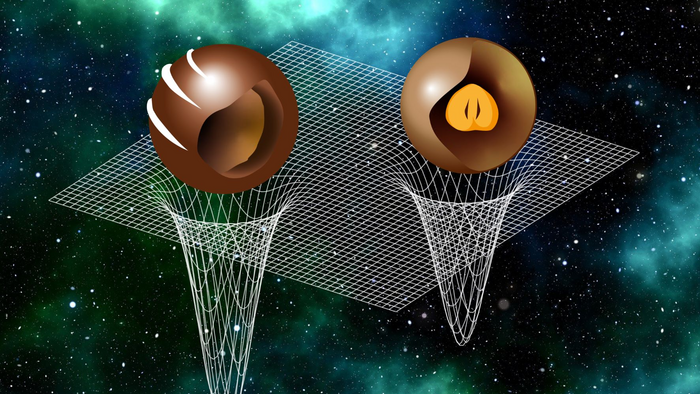Sweet! Neutron stars are like cosmic chocolates, with hard or soft shells and centers
Sweet new research suggests that some neutron stars have stiff mantles and soft cores, while others have soft exteriors and stiff hearts, just like different types of chocolates.

Neutron stars resemble different types of cosmic candies: Light neutron stars have soft shells and stiff cores, making them akin to nut-filled chocolate pralines, while their heavy counterparts have stiff mantles and soft cores, more like truffles, new research suggests.
Physicists reached this surprising conclusion by developing over a million different equations of states for neutron star interiors that considered both theoretical nuclear physics and actual astronomical observations of these extreme stellar remnants.
"This result is very interesting because it gives us a direct measure of how compressible the center of neutron stars can be," Luciano Rezzolla, an astrophysicist at the Goethe University Institute for Theoretical Physics in Germany and one of the authors of the study, said in a statement. "Neutron stars apparently behave a bit like chocolate pralines: light stars resemble those chocolates that have a hazelnut in their center surrounded by soft chocolate, whereas heavy stars can be considered more like those chocolates where a hard layer contains a soft filling."
Related: A new approach might help scientists see inside a neutron star
A neutron star forms when a stellar core with a mass around that of the sun or larger collapses to form a roughly city-size remnant, giving rise to extreme conditions and material so dense that a single teaspoon of it would weigh 4 billion tons (3.6 metric tons).
These extreme conditions have prevented neutron stars from being effectively simulated on Earth, meaning that the interiors of these stellar remnants have remained shrouded in mystery for the 60 years since their discovery.
Rezzolla and his colleagues investigated the interiors of neutron stars by measuring the speed at which sound propagates through them. This technique is commonly used for more everyday objects with the compression that sound waves cause as they travel, thus helping to determine the stiffness or softness of the matter through which the sound waves travel. For example, this speed-of-sound methodology has been used with considerable success to explore Earth's interior and to locate oil and other deposits.
Get the Space.com Newsletter
Breaking space news, the latest updates on rocket launches, skywatching events and more!

Applying the propagation speed of sound to their equations of state, the researchers discovered that below a mass of 1.7 times that of the sun, a neutron star would be soft inside and stiff outside, while the situation would be reversed for neutron stars with masses greater than 1.7 solar masses.
In addition, the team's research revealed some other previously undetermined characteristics of neutron stars. Particularly, the team calculated that, regardless of their mass, neutron stars likely have radii of only around 7.5 miles (12 kilometers), which is roughly the diameter of Frankfurt, the home of Goethe University. This uniform size may seem unlikely, but all neutron stars start life as cores with between 1.18 and 1.97 times that of the sun, any small differences in the size of these cores would become insignificant when they compressed down to a radius of just a few miles.
The research could also have implications for how neutron stars in binary systems launch gravitational waves, tiny ripples in space-time that can be measured by incredibly sensitive laser interferometers on Earth.
"Our extensive numerical study not only allows us to make predictions for the radii and maximum masses of neutron stars but also to set new limits on their deformability in binary systems — that is, how strongly they distort each other through their gravitational fields," Christian Ecker, a scientist at Utrecht University in the Netherlands and co-author of the study, said in the statement. "These insights will become particularly important to pinpoint the unknown equation of state with future astronomical observations and detections of gravitational waves from merging stars."
The team's research was published Nov. 10 in The Astrophysical Journal Letters.
Follow us on Twitter @Spacedotcom or on Facebook.
Join our Space Forums to keep talking space on the latest missions, night sky and more! And if you have a news tip, correction or comment, let us know at: community@space.com.

Robert Lea is a science journalist in the U.K. whose articles have been published in Physics World, New Scientist, Astronomy Magazine, All About Space, Newsweek and ZME Science. He also writes about science communication for Elsevier and the European Journal of Physics. Rob holds a bachelor of science degree in physics and astronomy from the U.K.’s Open University. Follow him on Twitter @sciencef1rst.









